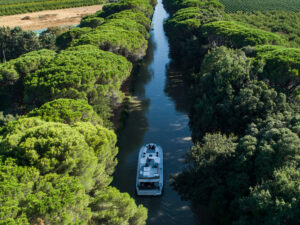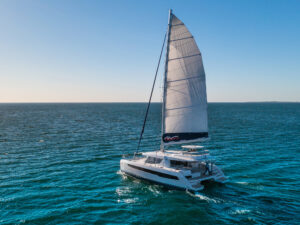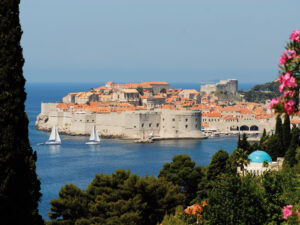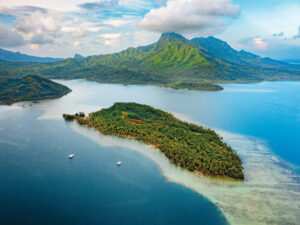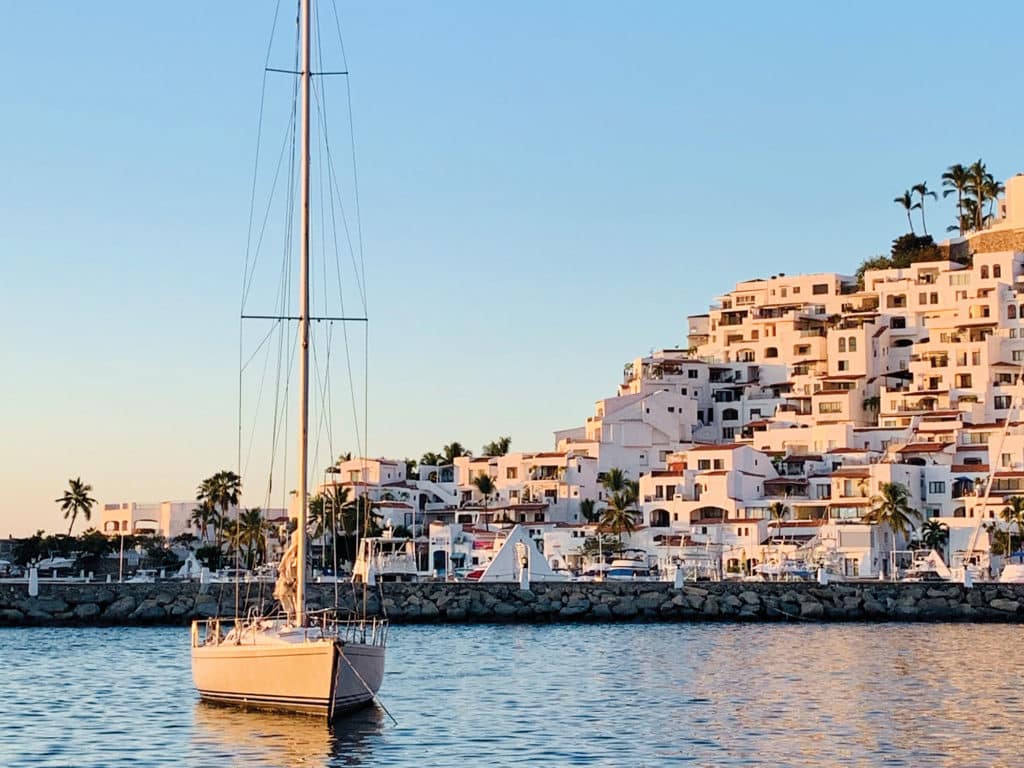
To invite or not to invite? In the matter of having guests aboard for days at a time, cruisers mostly belong in one of two camps. It’s either “You bet!” or “No way!”
My wife, Rebecca, and I understand all the reasons why other sailors say no (sharing small spaces, always needing to be “on,” herding cats, fixing heads, feeling responsible for other people’s happiness and safety). But we invariably say yes.
We both have a hospitality mindset, honed through years of working professionally as yacht crew. We take the business of having fun seriously, and we genuinely enjoy sharing our time, talents and toys with others. Having friends and family visit our own modest cruising boat is a challenging yet rewarding game we enjoy playing together.
When planning our trips with guests, the first thing we look for is consistently nice weather. If people are flying in and have moved heaven and earth (and that hard-to-get dog sitter) for these few precious days, you want sunny skies and fair winds. You don’t want to wait out a norther that’s blown out all the best anchorages, or deal with days of rain and squalls. So we try to find a place that, in season, provides day after day of nice conditions.
Next on our list is places to provision. Beyond weather, the other thing that makes the trip, as any pro crew can tell you, is what’s on the table. Rebecca loves to make and serve good food, and she needs the ingredients to do it.
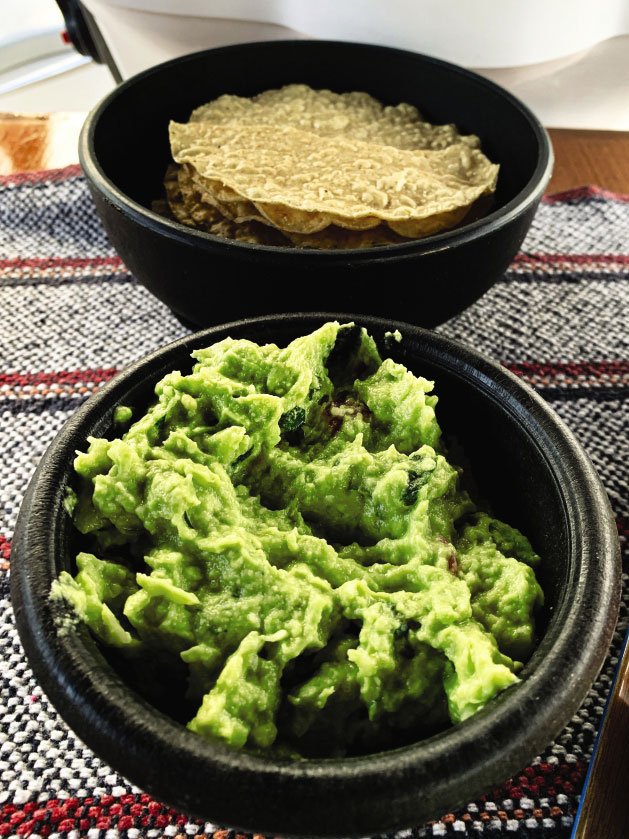
We also look for a variety of experiences, with relatively short distances between anchorages. Part of what we love to share about the cruising life is the contrast between civilization and the wild, between relaxing and exploring. We have learned that long days of sailing burn out the guests, leaving little time for eating, socializing and land excursions. And we like to cruise downwind and one way if possible. If you’re going to deliver the goods, why not go for the best sailing conditions? One-way travel shows off the best anchorages while economizing precious time.
It’s also important to have cell service and/or Wi-Fi. Most of us cruisers know how to carve out blissful days and weeks of being unplugged. But expect your guests to need to stay in touch. Another must-have is transportation hubs. Ideally, you will pick up and drop off your guests near a major airport, and you will meet them at a dock. Having made some insane surf landings in a dinghy filled with guests in nice clothes clutching their luggage and electronics, I can tell you that this is important.
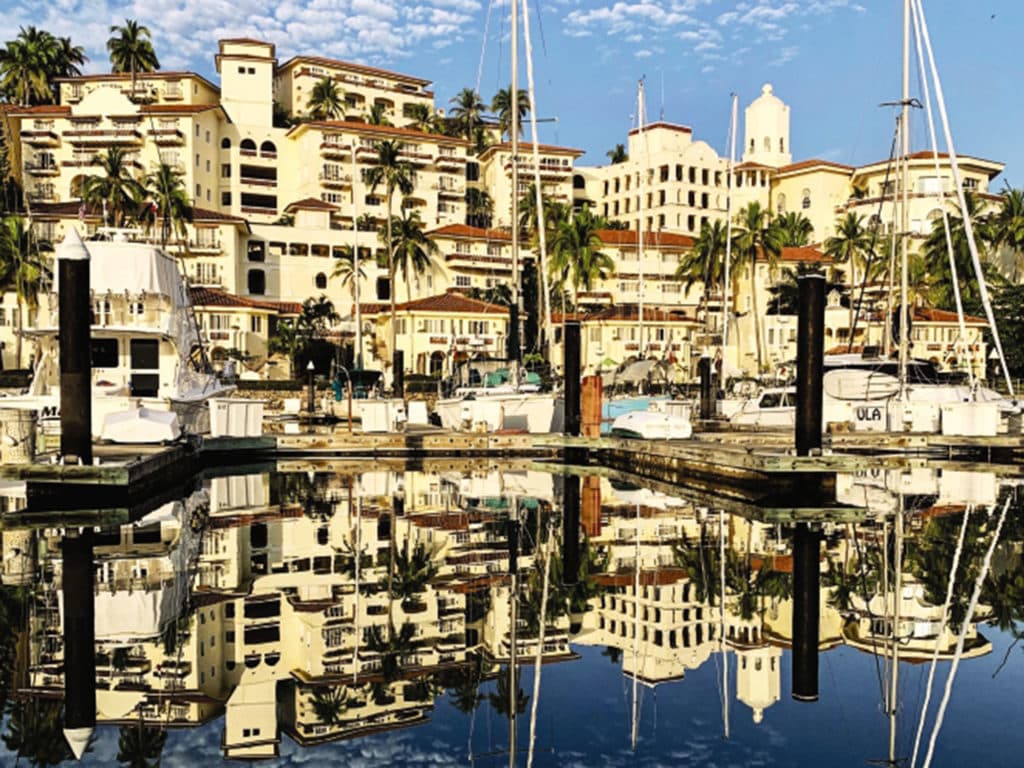
Based on these criteria, we’ve found several places in our voyages that fit the bill nicely. Our latest favorite is the Costalegre, a sublime stretch of largely undeveloped Pacific coastline south of Puerto Vallarta, Mexico.
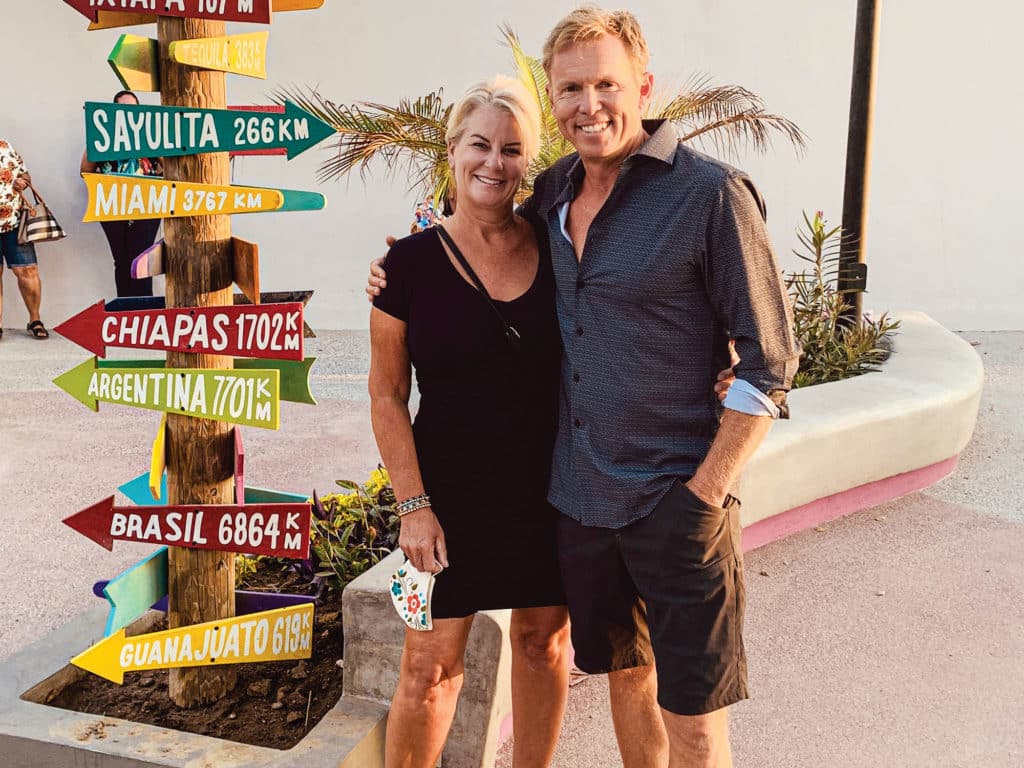
This cruising ground has fine weather in winter, with sea temperatures warm enough that swimming is enjoyable. There is plentiful marine life. The route has excellent marinas at either end, tranquil anchorages along the way, and miles of untouched golden beaches. And thanks in part to billionaire telecom pioneer Carlos Slim—whose 52-meter Feadship, Ostar, frequents these waters—there is cell service along much of the route. We have an AT&T unlimited plan, which gives us calls and data in Mexico at no extra expense.
Our itinerary is planned well in advance. By now, we know better than to just wake up every morning and ask, “What do you guys want to do?” The plan must have regular mealtimes and a set schedule for everything. Otherwise, half the boat wants to do one thing, half another. Without some order, people neglect their sunscreen and forget to eat. Misery ensues.
“We just want to spend time with you on the boat,” your friends might say.
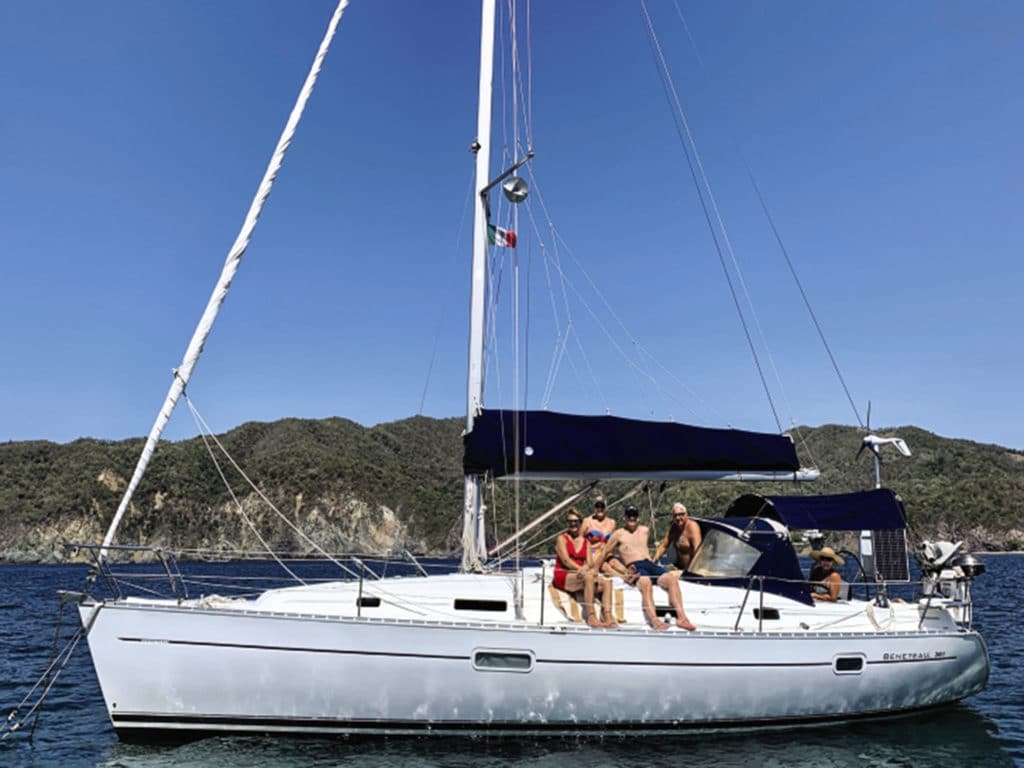
But it’s unlikely they really want to do nothing at all. It takes a well-practiced layabout, far from the shores of deadlines and industry, to suspend all Type A impulses and just be. Anchor out, sleep in, eat breakfast sometime after noon, swim, sunbathe, read and repeat. Our ideal day is not for everyone! Nor do the guests want to wait out a three-day blow while organizing every locker to pass the time.
“We’ll help with anything you need,” they say.
But that does not mean they want to scrub the bottom, replace the holding-tank macerator, or polish anything. They definitely would not enjoy standing watch in a marginal anchorage and shining the spotlight anxiously on a jagged lee shore all night long. And guests should not be cooking or barbecuing on a boat in which they know nothing of its hazards, workarounds and idiosyncrasies. The duty of squeezing a pile of fresh, juicy Mexican limes might be a better fit.
Down Mexico Way
“South of the border”—as Sinatra crooned—on the Costalegre, we start the trip from Puerto Vallarta, where guests can arrive on any number of cheap daily flights. We dock our Beneteau 361, Liberte, at either Paradise Village Marina or Marina Village Nayarit at La Cruz so we can tidy up, do laundry, wash the boat, and fill the tanks prior to guest arrival. For provisions, we head to Costco, or the equally impressive big-box stores Soriana or Chedraui. Rebecca soaks the fruits and veggies in our sinks using Microdyn or BacDyn Plus, both readily available.
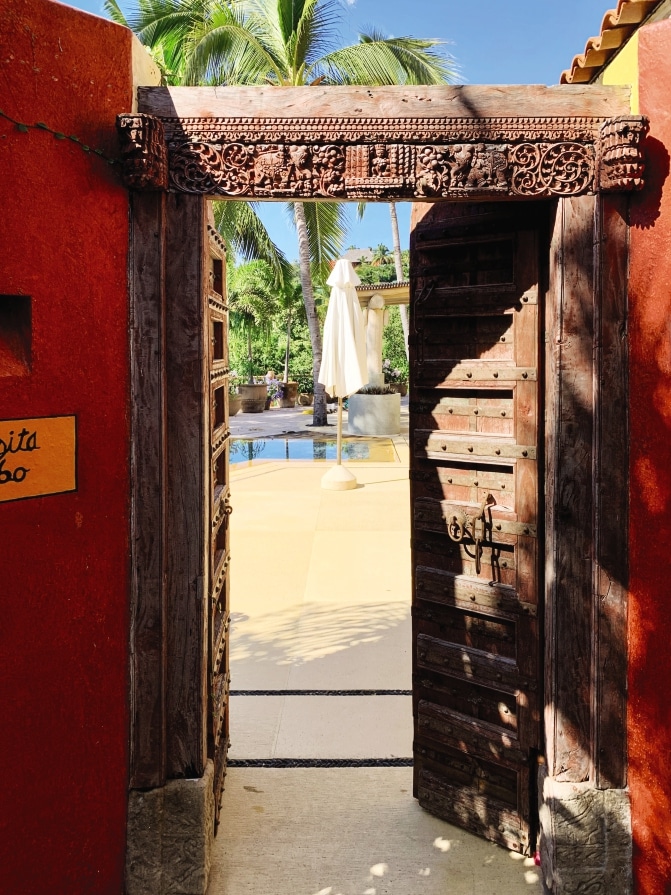
Prior to a trip, we have our guests fill out preference sheets, another carryover from our previous experience as charter crew. These list emergency contacts and passport numbers, along with any medical conditions and food allergies. We also remind them not to pack much. (Besides, we’ll need room in their luggage for that inevitable replacement boat part or last-minute Amazon order.)
When the airport taxi drops our guests at Liberte, appetizers and drinks are waiting. In these waters, it’s margaritas, guacamole and pico de gallo, all made from scratch. Our guests get a boat orientation, including the all-important tutorial on using the head. We talk about conserving water and power, how to charge their devices, and how to make coffee if you’re the first person up.
Banderas Bay is a destination in its own right, a fun place to spend some time before you head south. Begin eyeballing the weather forecast for rounding Cabo Corrientes, which like any cape, big or small, deserves respect. Mike Danielson, who runs PV Sailing, offers a daily weather briefing on the Banderas Bay cruiser’s net at 0830, Monday through Saturday, on 22A.
Check out the farmers market on Sunday in La Cruz and Tuesday in Paradise Village. The Paradise Village Yacht Club holds a regular racing series on the bay, with its amazingly consistent sea breeze that fills in every afternoon, bang-on schedule. And Marina Village Nayarit holds a steady stream of seminars on all things cruising.
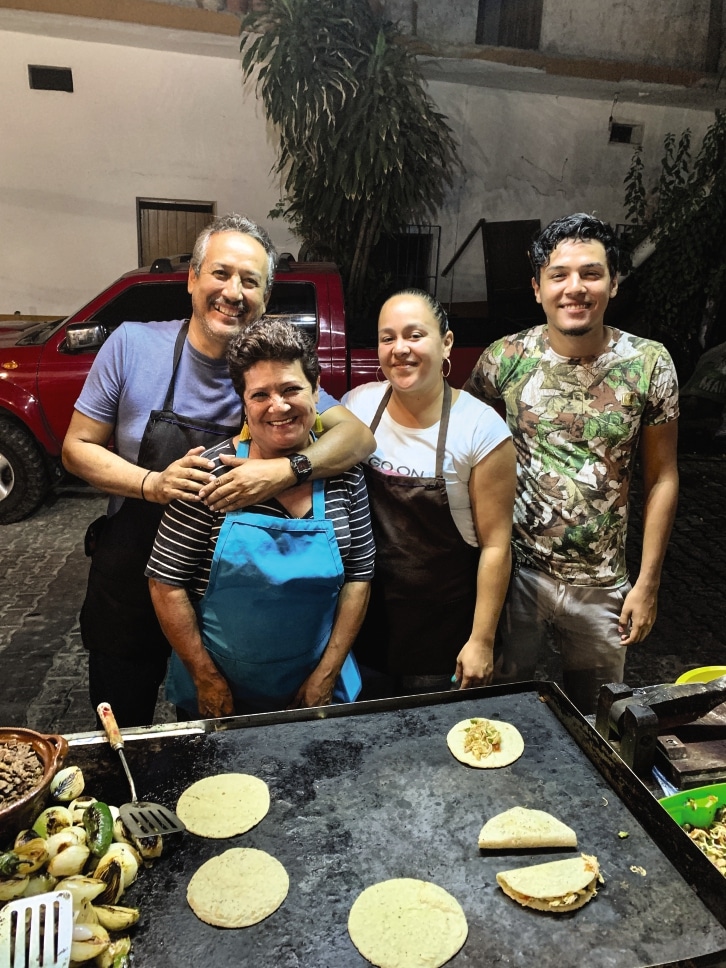
If you’re in La Cruz, definitely wander the town in the evening and eat some streetside tacos. In Paradise Village, your guests can stroll the resort to see the resident tigers (rescued from private collectors) and swim in one of the resort’s pools. As you sail Banderas Bay, dolphins will certainly greet you at some point, and possibly humpback whales. Off La Cruz, you’ll often see Lasers from the International Sailing Academy, tacking and jibing crisply under the guidance of Olympic coaches.
When it’s time to go south and you have a favorable forecast around Cabo Corrientes, consider an overnight passage. Technically, you can pull into Punta Ipala, just past Cabo Corrientes, but there isn’t a lot of room in the anchorage due to underwater hazards and fishing boats on moorings. So, a better landfall is Chemela Bay, which is 90 miles or 15 hours of sailing away, your longest passage on this trip. We like to depart in midafternoon to catch the tail end of the sea breeze, round the cape at sunset, and arrive in Chemela after sunrise.
RELATED: Sailing to Mexico with the Baja Ha-Ha
The prevailing winter seasonal breeze along the Costalegre is out of the northwest, which makes for a nice broad reach as you go. The swells are also pushing from astern. The sea breeze dies out around sunset, but if you’re lucky, a land breeze will come up by midnight. Now you’ve switched from starboard to port tack, sailing upwind but in mellow conditions. I’ve always enjoyed the contrast of booming along this coast in a rollicking sea breeze, followed by the subtleties of night sailing in a fragrant offshore wind.
Chemela Bay is a lovely place to spend some time. If the Pacific swell is mellow, find an anchorage amid the 11 islands in the bay, a protected nature sanctuary. The snorkeling here among the rocks can be grand, as is exploring by paddleboard. We keep two inflatable boards on Liberte’s deck for just such an occasion. If there is a swell and the anchorages look like they have too much surge, head for the northwest corner of the bay and anchor off the little fishing town of Punta Perula.
Here, as throughout your trip, you will see pangas and their pangeros handling them with skill. Sometimes you might think that they’re passing too close and too fast to your anchored boat for your taste, but these are their home waters, and they know the way. The pangeros are a breed all their own: part Old Man and the Sea, part gondolier. If they see you in need, pangeros will come to your aid. If it’s fish you desire for dinner, wave them over and arrange a trade. Much like cruisers, these men enjoy the freedom of the ocean and are self-sufficient and super-handy.
Chemela offers a chance to stroll the beach for as far as your legs want to go. If waves are booming and you don’t want to try your luck with a surf landing, head up the little inlet near town and tie up where the local boats do. If the cook needs something extra for the galley, you can buy it in one of the excellent small tiendas. Or enjoy a meal on the beachfront. For dessert, make sure to hail a passing vendor and buy their cocadas. These homemade candies from shredded coconut and condensed milk are pure heaven.
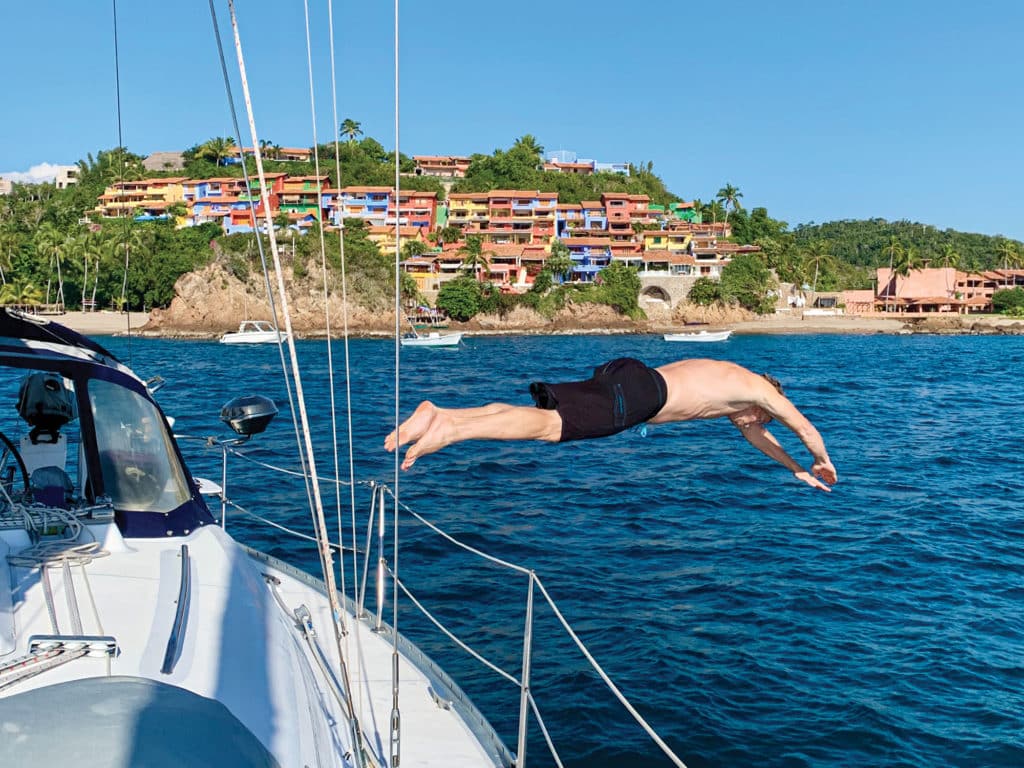
On Liberte, the pool is always open. We have a boat with a sugar-scoop stern, so once the ladder goes down (with a suitable briefing about currents or any other hazards), we have the world’s best swimming hole off the back of the boat. We also teach our guests the cruiser’s trick of rinsing off with the deck shower after the afternoon (or night) swim, so they’ve done double-duty and showered too. This helps avoid the water tanks running dry—one of the banes of having guests aboard.
From Chemela Bay, as you can see by consulting your cruising guide (we recommend the splendid Pacific Mexico: A Cruiser’s Guidebook, by Shawn Breeding and Heather Bansmer), you will see that it is 30 nautical miles, or five hours sailing, to the next major anchorage. But if you have an extra day or so, and especially if the swell is relatively gentle, there are a couple of stops, often overlooked, that will add some extra magic to your voyage. Paraisio is a wild little pocket anchorage that defies description and is good in south winds. Careyes is a little slice of the Mediterranean, and if you look at the charts closely, you’ll see a place to anchor in decent protection off this super-exclusive enclave. The reward is a backdrop of brightly colored homes on the cliffs, an excellent restaurant on the beach, and a far-out, sun-soaked vibe where polo players mingle with reclusive artists and world travelers.
Kickin’ Way Back
The next stop is Tenacatita, where a little community of cruisers anchors for months at a go. You can tune in to the morning cruiser’s net to give your guests a taste of this life. The cruisers have a daily afternoon social hour where they swim to shore, walk the beach and play bocce, and they would welcome you to join. Or anchor out at the nearby—and aptly named—Aquarium, where your guests can snorkel to the reef right from the boat.
Rebecca loves to fish, so we cruise this coast with a line in the water and a lure dancing in our wake. If the reel sings, it might be dorado or tuna. The most frequent catch we’ve had lately is Pacific crevalle jack, a fish that fights so hard that its local nickname is toro, for bull. Not everyone sees this mighty gamefish as food, but we beg to differ. The best advice is to treat it like beef, and so we do. Bleed the fish right away, remove the bloodline (dark area with a strong taste), marinate for at least an hour, then grill to medium on the barbecue. Serve with horseradish. There’s your sea-to-table sustenance, as fresh and local as it gets.
Sooner or later on this coast, all routes lead to Barra de Navidad. In our beloved Barra, you can anchor in a protected lagoon, or take a slip at the marina in front of Grand Isla Navidad Resort. The town is low-key, colorful, full of great restaurants, and fun to explore. The French baker comes around by panga every morning, delivering a boatload of deliciously tempting goods. There’s yoga on the beach at the hotel, and water taxis anytime you need a ride to town.
Barra has its own charming, miniature malecon, where we go to watch earth-shattering sunsets and bask in the perfectly warm evenings. There’s indigenous art for sale, a surf shop and a small surf break. The local kids have perfected the tricky sport of skimboarding, and it’s a treat to sit on the beach in the afternoon and watch them have a go. Rent a beach umbrella for $5, sip from a fresh coconut, and plunge into the ocean and the sun at regular intervals until you’ve achieved seaside nirvana.
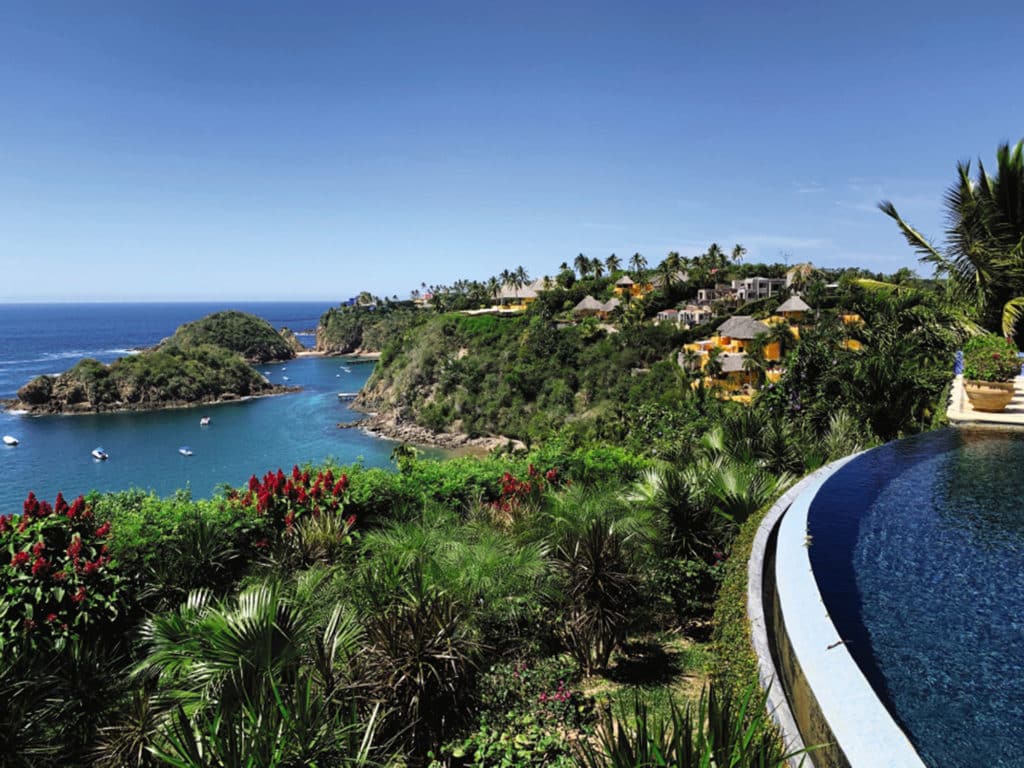
If it’s time for your guests to say adios, they can easily depart from here. They can hire a driver to take them back to Puerto Vallarta ($100 and three hours), or fly out of ZLO Manzanillo, which is only a 25-minute drive away. Or, if they want a final dose of the good life, head south one more day. Take an afternoon cruise down the coast to Las Hadas, go for a swim, and watch the lights twinkle on in this fairy-tale resort. It’s an easy taxi ride to ZLO from here.
If you’ve done your job right, your guests have had the trip of a lifetime. On their fair-weather Costalegre cruise, they browsed markets, combed beaches, explored little towns, ate their fill of fresh tacos, and marveled at whales. They enjoyed star shows, epic sunsets and sparkling mornings. They practiced their Spanish and added a new reality or two to their world. Perhaps you even managed to con them, Tom Sawyer-style, into cleaning the bottom or shining a bit of stainless, after all.
We always take plenty of photos, and we put together a Google Photos album of the best to send to our guests. We’ve found that our brains enjoy a trip three ways: the planning and anticipation, the travel itself, and the recollections.
And, perhaps most important, don’t forget a little R&R for the crew. Because, as Rebecca and I can attest, there is a little hideaway, just around the corner from the bright lights of Manzanillo’s port city. Go there, just for you. It’s a steep-walled anchorage with caves where you can hear the sea inhaling and exhaling. Wait for the first stars and a sliver of crescent moon, and listen to water ebbing and flowing all around you. It’s like floating in the middle of a haiku. After dark, strip down and jump in. The bioluminescence flickers around your body, electric blue. The Milky Way glows overhead.
By now, your guests are somewhere back in the (un)real world, and you are immersed in the gentle rhythms of the cruising life again. Together, you have added another bright chapter to life, thanks to that most excellent memory-making machine that is your sailboat.
David Kilmer cut his teeth on nautical hospitality in the Caribbean, as colorfully described in his book A Peril to Myself and Others: My Quest to Become a Captain.
How to be a “Superguest”
So we’ve explained how to be a great host. But how does one achieve greatness from the guest perspective? Here’s how:
- Pack light. Leave room to bring boat parts, the newest issue of Cruising World, and treats.
- Leave your troubles at home. Show up excited, curious and grateful. Sail in the now.
- Learn how the boat works. And help keep it in one piece. Don’t waste water or clog the head.
- Be a considerate shipmate. Go to bed when you see your hosts yawning. Take up a small space, and help keep a tidy ship.
- Share your preferences. Be specific when asked about what you want to drink, eat and do. “I’m easy” or “I’m good with whatever” doesn’t work.
- Find a small boat job. Learn the ship’s method to do dishes or swab decks, or be the trip photographer. Know that the crew usually does not need help.
- Keep your eyes sharp. If you see, hear or sense something amiss, let the captain know.
- Express gratitude. Offer cash, meals ashore, or a reciprocal experience in your favorite vacation spot. Write in the ship’s guest book about what you loved most.

